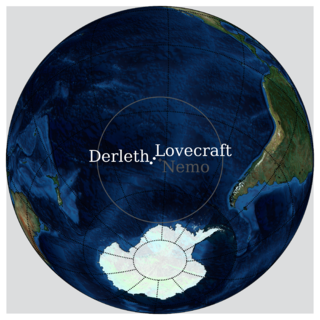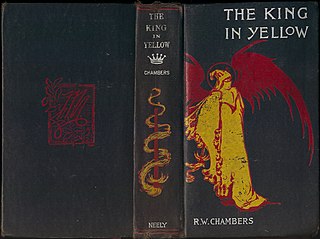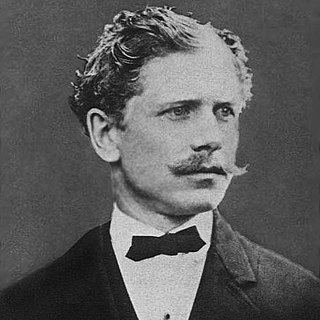
"The Death of Halpin Frayser" is a Gothic ghost story by Ambrose Bierce. It was first published in the San Francisco periodical The Wave on December 19, 1891 before appearing in the 1893 collection Can Such Things Be? [1]

"The Death of Halpin Frayser" is a Gothic ghost story by Ambrose Bierce. It was first published in the San Francisco periodical The Wave on December 19, 1891 before appearing in the 1893 collection Can Such Things Be? [1]

Halpin Frayser, a 32-year-old resident of the Napa Valley, awakens from a dreamless sleep speaking the mysterious words "Catherine LaRue" into the darkness. Earlier that day, Frayser went hunting in the vicinity of Mount Saint Helena. As he wanders the darkness and chooses a "road less travelled", it is clear there is something devious about. Halpin dreams about a haunted forest dripping with blood and is stricken with fear. In his dream, Halpin grabs a red-leather pocketbook and begins to write with blood a dark poem (in the manner of Freneau's "The House of Night" [2] ) but before he can write too much, he is confronted by the corpse of his mother.
The story then switches to Frayser's upbringing in Nashville, Tennessee. He never fit in with most of his family except for his mother. His penchant for poetry (albeit bad poetry) makes him a favorite to her. As Frayser becomes a young man, the relationship between mother and son is perceived as strange as they are together constantly. One day, Frayser tells her that he will go to California and though she initially tries to go with him, she relents. She has a dream that her son will die there by strangulation. While in San Francisco, Halpin is kidnapped onto a ship and spends several years at sea.
The story switches back to the day after Halpin's confrontation with his mother's corpse. A deputy and detective are walking the roads near where Halpin was last seen, looking for a criminal named Branscom. They heard he is in town and plan to capture him. He's wanted for slicing the throat of a woman in California. While exploring an area beyond a graveyard, they find a body that clearly was in a struggle before dying. They discover that this is Halpin's body and a poem on him that he had just written. Nearby, they discover another headboard with the name Catherine LaRue.
It's at this point that the officer remembers that Larue was Branscom's original last name and Frayser was the name of the woman whom Branscom killed. The detectives hear an "unnatural" and "unhuman" laugh that fills them with dread.
The most obvious interpretation of the story is supernatural: Halpin was killed by the zombie or lich-like corpse of his mother. [3] Years ago, she went to search for him in California and ended up by marrying Larue, her future murderer. After Halpin unknowingly approached her grave, the revenant "strangled her son literally, as she had strangled him metaphorically during her life". [4] As summarised by H. P. Lovecraft, the story "tells of a body skulking by night without a soul in a weird and horribly ensanguined wood, and of a man beset by ancestral memories who met death at the claws of that which had been his fervently loved mother". [5]
There is also a naturalistic interpretation: Halpin is killed by the maniac Branscom while dreaming that he is being strangled by his mother. [3] His dream is probably inspired by Catherine's premonitory dream of her son's strangulation in California. That all this happens by his mother's grave is just an improbable coincidence. This leaves unexplained the hideous unearthly laugh heard by the detectives, however. [6]
More recent commentators, including William Bysshe Stein and Robert C. Maclean, have highlighted the incestuous attachment between Halpin and his mother. [6] Maclean has speculated that after Halpin and his mother fled separately west, they lived as man and wife in California (although there is no indication of this in Bierce's text). S. T. Joshi went even further by claiming that it was Frayser who "killed his wife/mother but she came back from the dead as he lurked by her grave". [6] [7] According to Maclean, Halpin's murderer was no other than "his own father, disguised as the private detective Jaralson". [6]
The story has been viewed as "perhaps Bierce's most remarkable supernatural tale" [6] and a key precursor of zombie fiction. [4] In 1927, H. P. Lovecraft included "The Death of Halpin Frayser" among "permanent mountain-peaks of American weird writing". [5] For Frederic Taber Cooper, it was "the most fiendishly ghastly tale in the literature of the Anglo-Saxon race". [5]
"The Death of Halpin Frayser" has also been acclaimed as "an interesting pre-Freudian study of an Oedipal theme". [8] It has been noted that "Branscom/LaRue fulfills Frayser's deadly incestuous drive by killing the latter's mother". [9] "Halpin Frayser" supposedly goes beyond Bierce's other non-war stories in "reaching a truly rich measure of psychological complexity". [10]
The story's style is elaborate and its structure is complex. The murky dream sequence is wedged between two realistic narratives set in the daylight. [3] As Samuel Loveman has noted, "flowers, verdure, and the boughs and leaves of trees are magnificently placed as an opposing foil to unnatural malignity". [5]

The undead are beings in mythology, legend, or fiction that are deceased but behave as if alive. Most commonly the term refers to corporeal forms of formerly alive humans, such as mummies, vampires, and zombies, which have been reanimated by supernatural means, technology, or disease. In some cases, the term also includes incorporeal forms of the dead, such as ghosts.

R'lyeh is a fictional lost city that was first mentioned in the H. P. Lovecraft short story "The Call of Cthulhu", first published in Weird Tales in February 1928. R'lyeh is a sunken city in the South Pacific and the prison of the entity called Cthulhu.

The King in Yellow is a book of short stories by American writer Robert W. Chambers, first published by F. Tennyson Neely in 1895. The British first edition was published by Chatto & Windus in 1895.

In fantasy fiction, a lich is a type of undead creature.
"Supernatural Horror in Literature" is a 28,000-word essay by American writer H. P. Lovecraft, surveying the development and achievements of horror fiction as the field stood in the 1920s and 30s. The essay was researched and written between November 1925 and May 1927, first published in August 1927, and then revised and expanded during 1933–1934.

The Black Mass was a horror-fantasy radio drama produced by Erik Bauersfeld, a leading American radio dramatist of the post-television era. The series aired on KPFA (Berkeley) and KPFK from 1963 to 1967, on an irregular schedule. Bauersfeld was the Director of Drama and Literature at KPFA from 1966 to 1991.
Weird fiction is a subgenre of speculative fiction originating in the late 19th and early 20th centuries. Weird fiction either eschews or radically reinterprets traditional antagonists of supernatural horror fiction, such as ghosts, vampires, and werewolves. Writers on the subject of weird fiction, such as China Miéville, sometimes use "the tentacle" to represent this type of writing. The tentacle is a limb-type absent from most of the monsters of European folklore and gothic fiction, but often attached to the monstrous creatures created by weird fiction writers, such as William Hope Hodgson, M. R. James, Clark Ashton Smith, and H. P. Lovecraft. Weird fiction often attempts to inspire awe as well as fear in response to its fictional creations, causing commentators like Miéville to paraphrase Goethe in saying that weird fiction evokes a sense of the numinous. Although "weird fiction" has been chiefly used as a historical description for works through the 1930s, it experienced a resurgence in the 1980s and 1990s, under the label of New Weird, which continues into the 21st century.

Frank Belknap Long Jr. was an American writer of horror fiction, fantasy, science fiction, poetry, gothic romance, comic books, and non-fiction. Though his writing career spanned seven decades, he is best known for his horror and science fiction short stories, including contributions to the Cthulhu Mythos alongside his friend, H. P. Lovecraft. During his life, Long received the World Fantasy Award for Life Achievement, the Bram Stoker Award for Lifetime Achievement, and the First Fandom Hall of Fame Award (1977).

Sunand Tryambak Joshi is an American literary critic whose work has largely focused on weird and fantastic fiction, especially the life and work of H. P. Lovecraft and associated writers.
"The Exiles" is a science fiction short story by Ray Bradbury. It was originally published as "The Mad Wizards of Mars" in Maclean's on September 15, 1949 and was reprinted, in revised form, the following year by The Magazine of Fantasy & Science Fiction. First collected in The Illustrated Man (1951), it was later included in the collections R Is for Rocket (1962), Bradbury Stories: 100 of His Most Celebrated Tales (2003), A Sound of Thunder and Other Stories (2005) and A Pleasure to Burn. It was also published in "The Eureka Years: Boucher and McComas's Magazine of Fantasy and Science Fiction" (ISBN 0553206737).
Joseph Payne Brennan was an American writer of fantasy and horror fiction, and also a poet. Of Irish ancestry, he was born in Bridgeport, Connecticut and he lived most of his life in New Haven, Connecticut, and worked as an Acquisitions Assistant at the Sterling Memorial Library of Yale University for over 40 years. Brennan published several hundred short stories, two novellas and reputedly thousands of poems. His stories appeared in over 200 anthologies and have been translated into German, French, Dutch, Italian and Spanish. He was an early bibliographer of the work of H. P. Lovecraft.

"Herbert West–Reanimator" is a horror short story by American writer H. P. Lovecraft. It was written between October 1921 and June 1922. It was first serialized in February through July 1922 in the amateur publication Home Brew. The story was the basis of the 1985 horror film Re-Animator and its sequels, in addition to numerous other adaptations in various media.

Ambrose Gwinnett Bierce was an American short story writer, journalist, poet, and American Civil War veteran. His book The Devil's Dictionary was named one of "The 100 Greatest Masterpieces of American Literature" by the American Revolution Bicentennial Administration. His story "An Occurrence at Owl Creek Bridge" has been described as "one of the most famous and frequently anthologized stories in American literature", and his book Tales of Soldiers and Civilians was named by the Grolier Club one of the 100 most influential American books printed before 1900.
"I, Cthulhu" is a short humorous story by fantasy author Neil Gaiman featuring H. P. Lovecraft's Cthulhu, who is dictating an autobiography to a human slave named Whateley. The story reveals much about Cthulhu's 'birth' and early life.
"The Damned Thing" is a horror short story written by American Civil War soldier, wit, and writer Ambrose Bierce. It first appeared in Town Topics on December 7, 1893.

Adolphe Danziger De Castro, also known as Gustav Adolf Danziger, Adolph Danziger, Adolphe Danziger and Adolphe De Castro, was a Jewish scholar, journalist, lawyer and author of poems, novels and short stories.

Tales of Soldiers and Civilians is a collection of short stories by American Civil War soldier, wit, and writer Ambrose Bierce, also published under the title In the Midst of Life. With a stated publication date of 1891 the stories describe unusual incidents in the lives of soldiers and civilians during the American Civil War. Tales of Soldiers and Civilians was named by the Grolier Club as one of the 100 most influential American books printed before 1900, stating "These short stories are among the finest, and best known, in American literature. ... Written in a clear simple style, with each phrase contributing to the total effect, Bierce's tales pointed the way for the American short-story writer." Bierce's famous story "An Occurrence at Owl Creek Bridge" is included in this collection.
"The Moonlit Road" is a gothic horror short story by American Civil War soldier, wit, and writer Ambrose Bierce. It first appeared in a 1907 issue of Cosmopolitan magazine, illustrated by Charles B. Falls. This story is presented in three parts and relates the tale of the murder of Julia Hetman from the perspective of her son, a man who may be her husband, and Julia herself, through a medium.
"The Eyes of the Panther" is a short story by American Civil War soldier, wit, and writer Ambrose Bierce featuring a female werepanther. It was published in The San Francisco Examiner on 17 October, 1897 before appearing in his 1898 collection In the Midst of Life.
"The Middle Toe of the Right Foot" is a ghost story by American Civil War soldier, wit, and writer Ambrose Bierce. It was first published in The San Francisco Examiner on April 17, 1890, and was reprinted the following year as part of Tales of Soldiers and Civilians.